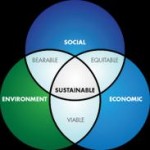GIGO: Garbage In, Garbage Out
That phrase reminds us that what you put into something is what you’ll get out of it. If you put garbage in – cheap parts, shoddy workmanship, no quality inspection, inaccurate data – that will determine what comes out.
I think it’s time to employ that thinking again to what we put into people who we count on for output.
Measure
To have a successful business, we measure outputs of profit, costs, which products sell, which don’t. To have a successful household, we measure savings, expenses, which foods are eaten, which become garbage. In both domains, we measure the financial bottom line. However, if that’s all we’re monitoring, we’re not seeing, and we don’t have access to influence, the factors that contribute to the kind of success we’re seeking today.
 The triple bottom line came into existence around 2007. The TBL registers an expanded spectrum of criteria for measuring organizational success with metrics for (1) people (social) and (2) planet (ecological), and (3) profit (economic). The concept demands that a company’s responsibility lies with stakeholders rather than only shareholders (profit-seekers), with “stakeholders” being anyone who is influenced, either directly or indirectly, by the actions of the firm. Corporate Social Responsibility is an expression of this measure. A step in the right direction.
The triple bottom line came into existence around 2007. The TBL registers an expanded spectrum of criteria for measuring organizational success with metrics for (1) people (social) and (2) planet (ecological), and (3) profit (economic). The concept demands that a company’s responsibility lies with stakeholders rather than only shareholders (profit-seekers), with “stakeholders” being anyone who is influenced, either directly or indirectly, by the actions of the firm. Corporate Social Responsibility is an expression of this measure. A step in the right direction.
Another step is to measure what’s going into our people.
GIGO or HIHO?
If people are in a toxic culture – one characterized by gossip, broken promises, poor communication, inequitable compensation, discrimination, retribution rather than support – their output is likely to be toxic– low morale, low customer satisfaction, increase in union grievances, high absenteeism.
If people are in and around an engaging, invigorating culture – one characterized by opportunity to learn, gain skills, supportive feedback, development paths that match ambitions – their performance and output will represent and reflect the culture; plus, they will experience work as satisfying. 
BTW: Creating an environment that fosters happy and satisfied employees does not mean that there won’t be conflict or disagreement. It means that when there is a conflict, it gets worked out and resolved in the open and doesn’t fester or go underground to sabotage relationships. The effectiveness with which employees raise and resolve disagreements is a function of the level of trust.
Employees are happiest when they’re trying to achieve goals that are difficult but not out of reach. As they go after these difficult and attainable goals, thriving employees know how to avoid burnout. (The Bright Side of Burnout: How to recognize & fix it! a motivational and training video available. 20% discount code: NOBURNOUT).
Research has shown that managers can take 4 measures to help employees engage in taking on difficult goals. All 4 are necessary to create a culture of vitality and learning. (Source: HBReview, Jan-Feb 2012 and my experience of working with tons of people around the world.)
- Provide decision-making discretion. Be clear about parameters.
- Share information. Share data on all aspects of business with everyone, regardless of role.
- Minimize incivility. Reduce (heck, Outlaw!) gossip, disrespect, intolerance and bullying.
- Offer performance feedback. Create dashboards that show individual and team performance against goals. When positive feedback outweighs the negative 5 to 1, satisfaction increases.
It will take a prolonged and shared commitment to bring these 4 measures into your workplace (or household). Old habits will need to be discarded, new practices will need to be invented and integrated. The process of creating a vital and learning environment can create happiness. Happiness in, Happiness out. After all, it’s the input that creates the output.
Subscribe
Get Camille's latest posts!
